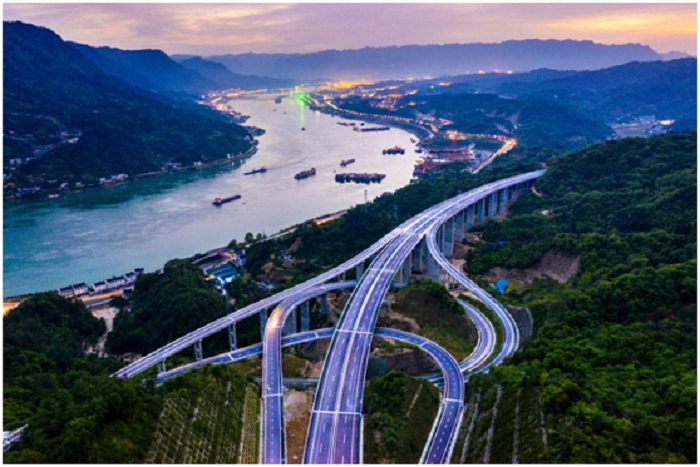



If you enter the Xiwu exit ramp of Fenghua, Ningbo, east China’s Zhejiang province along the Shenyang–Haikou expressway and drive all the way westwards along Dacheng East Road, it will only take three minutes to reach the downtown area of Fenghua.
Now, the Shenyang–Haikou expressway, the Ningbo loop expressway and the Ningbo–Jinhua expressway, which all pass through Fenghua, have formed a fast and convenient regional transport network after being connected by link roads.
A vast number of vehicles are running on these expressways every day, injecting constant energy into regional development.
Expressways mirror the rapid development of China’s urban and rural construction.
According to local residents in Fenghua, poor transportation was once a barrier that hindered investment projects in the past. Years ago, Ye Taihai, an entrepreneur of Fenghua descent returned to the district and invested in local road construction. What he did enabled Fenghua to enjoy the dividends of China’s reform and opening up.
Today, transportation is not any longer a weak link of Fenghua, and all of its townships can get to an expressway within 30 minutes. The convenient transportation has even become an advantage of the district in attracting investment.
From muddy roads to modern road networks, cities today are closely connected, which can better facilitate economic and cultural exchanges, as well as the flow of personnel. More and more counties are witnessing faster industrialization and modernization driven by the construction of expressways.
Expressways mirror the improved livelihood of the Chinese people.
In the past, it took at least half an hour for residents in Qixi township, Quzhou, Zhejiang province to get to neighboring townships to ship and fetch express delivery parcels. The poor transportation was standing between local residents and a well-off life.
At the end of 2018, an interconnectivity project linking the Huangshan-Quzhou-Nanping expressway and the Qianjiangyuan National Forest Park in Quzhou was completed. It now serves as a channel for local residents to sell their farm produce to every part of China and makes it more convenient for tourists from surrounding provinces to visit the park. The project also prospered tourism, and local residents are embracing a better life by running agritainment facilities and B&Bs. Connecting cities and the countryside, expressways are bringing tangible benefits to the people.
Expressways also mirror the synergetic development of China.
Due to the special landforms in Zhejiang province, the progress of expressway construction was uneven. Thanks to the completion of the Wencheng-Taishun expressway during the 13th Five-Year Plan period (2016-2020), all onshore counties of Zhejiang have been connected to expressways.
In the following five years, to optimize industrial, urban-rural and regional structures for common prosperity will be a focus of Zhejiang province. It will transform single-mode transport into a multidimensional one, improve its comprehensive transport capability, and modernize its traditional transport, so as to make its transportation greener and safer with better quality.
From building the very first expressway of China – the Shanghai–Jiading expressway – in October 1988, China had constructed a total of 160,000 kilometers of expressways as of the end of the last year. The criss-cross expressways are connecting not only mountains and rivers, rural areas and cities, but also cultures and economy. They are showcasing the speed of China’s development.


The Humanitarian Service Diamond Awards has.
A Chinese Company, Inner Galaxy Steel.


The Programme Coordinator, Regulatory, Compliance and.


A Non-Governmental Organization (NGO), Committee for.
The Trustfund Pensions Limited has chided.


The House of Representatives Committee on.
The China General Chamber of Commerce.


Senator Chuka Utazi who represented Enugu.


An Abuja based Legal Practitioner, Ugochukwu.


The African business community in Yiwu,.
Leave a Comment